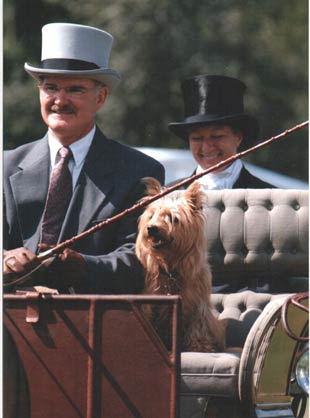
I have been involved in showing my carriages for forty years, and find that joining the American Driving Society and the Carriage Association of America is an excellent start in obtaining the information needed today to compete successfully in carriage competition.

- American Driving Society 2324 Clark Rd., Lapeer, MI.48446. phone 810-664-8666 fax 810-664-2405 Web:www.amricandrivingsociety.org
- The Carriage Association of America 177 Pointers-Auburn Rd., Salem NJ 08079 phone 856 935 1616 fax 856 935 9362 e-mail carrassc@mindspring.com web: www.caaonline.com
- The Carriage Museum of America-Library PO Box 417 Bird cIN- Hand, PA 17505 Phone: 717-656-7019 fax 717-656-6251 Web: www.carriagemuseumlibrary.org
The American Driving Society (ADS) publishes a handbook outlining updated rules and lists of what a judge is looking for in a proper turn-out. The Carriage Association publication contains numerous articles of interest on all phases of driving. One of the books they offer, On The Box Seat, by Tom Ryder contains a wealth of information on turn-out. From these publications, together with asking for some help from people in the know, there is plenty of information to assist the novice driver. With the revival of driving for pleasure and the increasing interest in driving competitions, we see everything from the run-about, to the inimitable marathon war wagons”. The driver who wants to look smart and be as correct as possible in the show ring or in presentation, can be so no matter what he is driving.
There are certain "rules” in driving that cover any circumstance. The way you hold your reins is optional but you may be asked to hold the reins in one hand. That does not mean that you cannot assist with the other hand. There are many "styles”, pick the one most comfortable for you. Sit on the right side of the seat.(age old English etiquette ) Have a whip in hand (The whip is an aid and the horse should be trained to it) Carry a spares kit. (walking home is no fun!) Display a slow moving vehicle sign any time your drive on a public road. Wear a hat (to keep the sun out of your eyes). Use an apron.(optional unless showing, to keep you clean and warm) Wear gloves.(to save your hands) The driver, or whip, is always the first in and last out of a carriage. Never take the bridle off your horse unless it has been unhitched from the vehicle.
Harness
Always use a black harness with a painted vehicle and a russet or brown
harness, with a vehicle that is entirely finished in natural wood, and iron
painted brown. If you have a natural wood vehicle and only own a black harness
then paint all the iron on the vehicle black and change all the leather (dash,
fenders, shaft leathers) to black. This 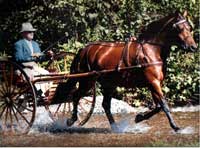 will
make it a correct turn out. If the vehicle is light, such as a run-about, sleigh,
or cart, only a breast plate is needed to pull the vehicle, but if you plan
to drive a heavy surrey or a large phaeton, then a collar is in order. Collars
are considered more formal and may not be appropriate for every vehicle. The
metal fitting on your turn out should all be the same color i.e. all silver
or all chrome or all brass. And if you use lamps then they should matc
will
make it a correct turn out. If the vehicle is light, such as a run-about, sleigh,
or cart, only a breast plate is needed to pull the vehicle, but if you plan
to drive a heavy surrey or a large phaeton, then a collar is in order. Collars
are considered more formal and may not be appropriate for every vehicle. The
metal fitting on your turn out should all be the same color i.e. all silver
or all chrome or all brass. And if you use lamps then they should matc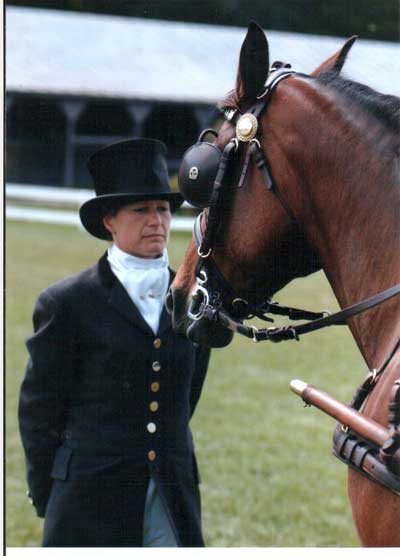 h
the metal color of the harness. And if your vehicle requires formal livery then
the buttons on the coat should match as well. The saddle of the harness varies
in width from 3 inches for a 4 wheeled vehicle to a wide pad for a 2 wheeled
vehicle (it is wide because in a two wheeled vehicle all the weight rests on
the animals back and the pad will then distribute the weight and make it more
comfortable for the horse). There are wide pads that can be placed under a narrow
saddle in order to make the harness suitable for a two wheeled carriage. A gig
pad is very wide and has tugs that slide through the saddle in order to balance
the weight of a gig. Breeching is required when the vehicle is not equipped
with brakes. Some formal turn-outs can use a strap called a false” breeching.
After hearing about some very serious accidents, I discourage the use of clips
or snaps to attach the breeching to the cart. Take the time to use the straps.
h
the metal color of the harness. And if your vehicle requires formal livery then
the buttons on the coat should match as well. The saddle of the harness varies
in width from 3 inches for a 4 wheeled vehicle to a wide pad for a 2 wheeled
vehicle (it is wide because in a two wheeled vehicle all the weight rests on
the animals back and the pad will then distribute the weight and make it more
comfortable for the horse). There are wide pads that can be placed under a narrow
saddle in order to make the harness suitable for a two wheeled carriage. A gig
pad is very wide and has tugs that slide through the saddle in order to balance
the weight of a gig. Breeching is required when the vehicle is not equipped
with brakes. Some formal turn-outs can use a strap called a false” breeching.
After hearing about some very serious accidents, I discourage the use of clips
or snaps to attach the breeching to the cart. Take the time to use the straps.
Collars
Collars come in two types. The "K”,
or closed collar, is use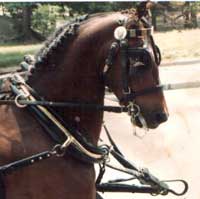 d
on the more formal harnesses and is often covered with patent leather. Open
collars are used more often in work harness. Collars are measured from the inside,
bottom to top. The average horse's neck will take about a 21 inch collar. Fit
of the collar is very important in order to not hinder the horse in his paces.
There are small blocks that can be used to make a collar too big fit better,
but there is no way to make a collar too small work.
d
on the more formal harnesses and is often covered with patent leather. Open
collars are used more often in work harness. Collars are measured from the inside,
bottom to top. The average horse's neck will take about a 21 inch collar. Fit
of the collar is very important in order to not hinder the horse in his paces.
There are small blocks that can be used to make a collar too big fit better,
but there is no way to make a collar too small work.
Whips
The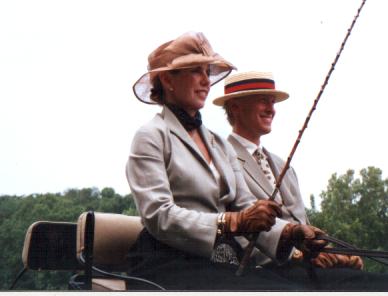 whip is carried in your hand for safety to use as an aid. Whips vary in length.
If you are driving a single, then the thong should be about half the length
of the stick. If driving a pair then the thong should be the length of the stick.
And if driving a tandem or four then the thong should be 6 to 10 feet long.
A rule of thumb for size is to be able to reach the shoulder of the horse with
the lash to give an aid. There are many kinds of materials used to make whips,
the whip made of holly wood being the most traditional.
whip is carried in your hand for safety to use as an aid. Whips vary in length.
If you are driving a single, then the thong should be about half the length
of the stick. If driving a pair then the thong should be the length of the stick.
And if driving a tandem or four then the thong should be 6 to 10 feet long.
A rule of thumb for size is to be able to reach the shoulder of the horse with
the lash to give an aid. There are many kinds of materials used to make whips,
the whip made of holly wood being the most traditional.
Lamps
I have not found any good books as
yet on which lamp goes with which vehicle, 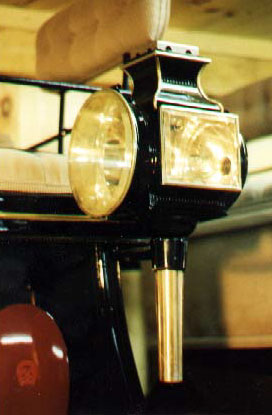 but
a good rule of thumb to follow is a square glass lamp goes with a formal vehicle,
such as a Victoria or Brougham, and a round or oval shaped lamp on a sporting
vehicle, such as a trap or Meadowbrook. American lamps hang on metal hooks attached
to the carriage, and English lamps hang in a circular holder.
but
a good rule of thumb to follow is a square glass lamp goes with a formal vehicle,
such as a Victoria or Brougham, and a round or oval shaped lamp on a sporting
vehicle, such as a trap or Meadowbrook. American lamps hang on metal hooks attached
to the carriage, and English lamps hang in a circular holder.
Clothing
Driving attire is often worrisome to new drivers. What
is sporting? Formal? Proper for spring, summer or fall? Tom Ryder offered the
best advice I have ever heard, wear what the weather dictates. So, if it is
hot, wear a nice light shirt or blouse. If it is raining, wear a raincoat. If it is cold, a jacket
is in order. Most of all, be comfortable. Take the time to rehearse your outfit
with a friend who can take your picture in your carriage. If you are still unsure,
send the picture to someone who has show experience. You want to look the part,
ie, sporting means that you look like you are heading for a picnic in the country
and formal means that you are stepping out on the town.
light shirt or blouse. If it is raining, wear a raincoat. If it is cold, a jacket
is in order. Most of all, be comfortable. Take the time to rehearse your outfit
with a friend who can take your picture in your carriage. If you are still unsure,
send the picture to someone who has show experience. You want to look the part,
ie, sporting means that you look like you are heading for a picnic in the country
and formal means that you are stepping out on the town.
Hat
Hats can make or break the appearance
of a turn-out, so take some time picking one that looks good on you. A popular
summer hat for a man is the straw boater as it goes with most turn-outs. A cap
or Fedora will also work with most carriages. A grey bowler is more formal,
but not everyone looks good in one. If the vehicle is formal then a  gray
or black topper is ideal for driver and passengers. (grooms
gray
or black topper is ideal for driver and passengers. (grooms 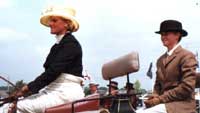 wear
black toppers). For woman in summer a straw hat with a firm brim, in winter
a felt hat is appropriate. In recent years, woman are turning out with larger
hats and adding more color. If you are a woman driver look pretty, don't dress
like a man, but the overall appearance should still be a little on the conservative
side.
wear
black toppers). For woman in summer a straw hat with a firm brim, in winter
a felt hat is appropriate. In recent years, woman are turning out with larger
hats and adding more color. If you are a woman driver look pretty, don't dress
like a man, but the overall appearance should still be a little on the conservative
side.
Apron
The driver and passengers of vehicles
wear an apron. It should wrap completely around the body and cover the body
from below the chest to mid-shin bone. Passengers may use a lap robe which is
large piece of material about 3 1/2 feet square that cover everyone on the seat.
These robes and aprons should be of a color which harmonizes with the material
of the seat. 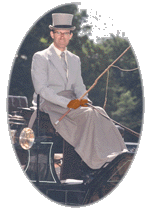 It
is sometimes advisable when having a lap robe or apron made to make it reversible,
thus going with the upholstery of different vehicles. It is also correct to
edge the apron and lap robe with the color matching the striping of the carriage.
Monograms add a nice touch. Gloves worn by everyone and should be dark brown
in color. Brown is chosen because the dye from a black glove could come off
on your hands. Your hands are very noticeable when driving, light gloves will
only add to that.
It
is sometimes advisable when having a lap robe or apron made to make it reversible,
thus going with the upholstery of different vehicles. It is also correct to
edge the apron and lap robe with the color matching the striping of the carriage.
Monograms add a nice touch. Gloves worn by everyone and should be dark brown
in color. Brown is chosen because the dye from a black glove could come off
on your hands. Your hands are very noticeable when driving, light gloves will
only add to that.
Shoes When driving wear shoes that go with the turn out. Brown with natural wood and leather, black to go with a painted vehicle. Remember the judge has a great view of your ankles so be sure your socks and not offensive or your apron covers this area.
Grooms The rules state that you must have an extra person for a pair and two for a four-in-hand. In combined driving, advanced single drivers must also must carry a groom.
Sporting |
If you want to look really smart, then your extra person should be dressed in some sort of livery. It can be as simple as a cap, jacket, tie, buff color pants and leather shoes, brown gloves. |
| If your vehicle is more formal then formal dress livery is in order. This consists of a black top hat white stock fitted body coat (with buttons of the same metal color as the harness), white jods and high black boots with tan leather around the top (similar to what you see in the hunt field) and brown gloves. Grooms do not wear aprons. |
Formal |
A less formal turn-out can carry a person dressed as a passenger to fulfill this requirement. That person should dress in a complimentary manner as the driver (but please, not the same!) and wear a matching apron. The person should dismount and head the horses, just as a groom would, when asked to stand in a line up. A note on grooms. Be sure the person you choose is knowledgeable about your horse and vehicle. Please, do not ask children to perform this task as the groom can often be instrumental in preventing a mishap should a situation arise.
To
complete the picture of a beautiful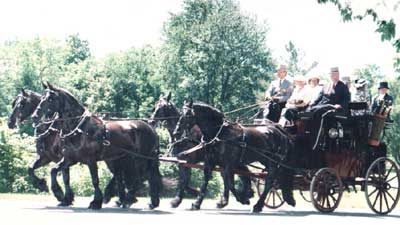 turn-out, it is assumed that your horse and your vehicle will have a balanced
look. You would not have a small horse pull a large carriage, not a very large
horse pull a small vehicle
turn-out, it is assumed that your horse and your vehicle will have a balanced
look. You would not have a small horse pull a large carriage, not a very large
horse pull a small vehicle
If I could be of any help in choosing a carriage or locating a harness, please feel free to contact me. Best of luck
John driving a four of Friesians to a Park Drag at the Devon Horse Show
John Greenall, 268 Kings Highway, West Windsor Vermont 05089 phone 802-436-2266 fax 802-436-2828 e-mail greenall@vermontel.net